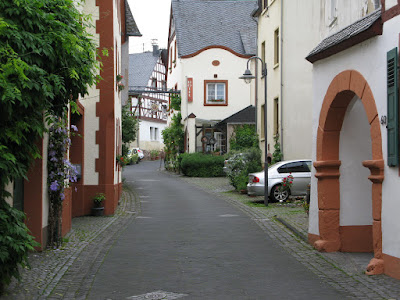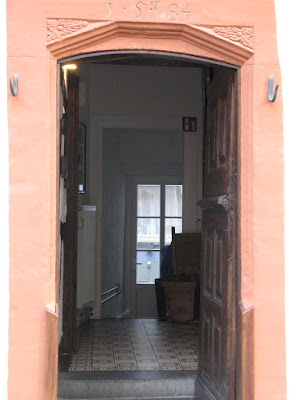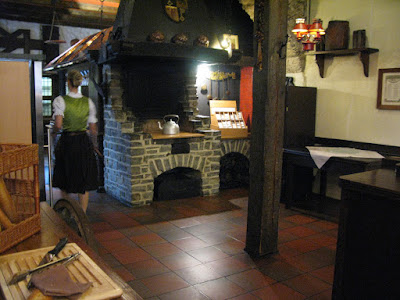Hi again, everybody, and
welcome back to Cépage et Cuisine, Mary’s and
Brian’s blog about wine, food, culture, and place. Today is Sunday. Most of the wine producers don’t receive
visitors on Sunday, so we didn’t venture out of the apartment until
lunchtime. Bernkastel was jammed with
tourists so we moseyed down the Mosel to Graach for something quieter and more
peaceful. It is only four kilometers
from Bernkastel to Graach, about 2.5 miles, practically walkable, but it feels
a world away, a tiny wine village on a quiet Sunday afternoon.
Because it was the only
place open, we went to the Weinhaus Hotel
zum Josefshof for lunch. Hof is a word that translates roughly to
“place,” so we would probably call it Joe’s Place here in the U.S.
Once again, trying to
avoid a giant lunch but also enjoy something local and authentic, we had the weisswurst, a white sausage of veal,
pork, herbs, and seasonings, served with a soft pretzel and mustard. If you search for information about
weisswurst on Google and look at the photos, it looks exactly like this, so it is
apparently a classic German dish. I had
fries with mine.
Downstream past
Zeltingen, we came upon this monstrosity under construction. It is the Hochmoselbrücke,
translated to High Mosel Bridge. The
idea is to enhance commerce and shipping between Frankfurt and the ports at
Antwerp and Amsterdam.
It is hugely controversial,
as you might expect. Local wine
producers are vehemently opposed, fearing its effect on the wine region. At the least, it spoils the natural beauty of
the valley and creates noise pollution.
I suppose progress marches on, but I sure am sorry to see this.
A quick look on Google Maps shows a major highway connecting Frankfurt and Amsterdam through Bonn, Cologne, and Dusseldorf in four hours. Do they really need this new highway?
A quick look on Google Maps shows a major highway connecting Frankfurt and Amsterdam through Bonn, Cologne, and Dusseldorf in four hours. Do they really need this new highway?
Back in Bernkastel on the
way to the apartment, this expression appears on the wall of the first building
in town. Wolfgang von Goethe was a poet,
writer, and politician of the late 1700s and early 1800s. The approximate translation as best I can
figure is:
I drank many wines, now I drink only you!
The Lord makes us, raised us, made the wine
And it loosens the tongues slavishly.
Yes, don’t spare the refreshment:
Because the oldest wine is dwindling from the barrel,
It keeps the boys young!
Johannes Haart suggested
the Zeltinger Hof in Zeltingen as a restaurant for dinner with an especially nice offering
of Riesling.
It is on this pretty back street in town, a typical German presentation with the ivy and window flower boxes.
It is on this pretty back street in town, a typical German presentation with the ivy and window flower boxes.
The wine list is literally on display on the walls. I love this kind of thing (and the girl in the picture).
The printed version is in a sturdy wooden book with hinged covers.
Somehow, that makes perfect sense here in Germany. There is just nothing like a 2 x 4 to bind a wine list!
Occasionally, whether
traveling or at home, we just place ourselves in the hands of the experts. We tell the server about our general
interests and desires and then accept recommendations.
We did that this time for the wine and enjoyed this beautiful spätlese feinherb Riesling by Weingut Paulinshof from the Kammer vineyard in Brauneberg.
We did that this time for the wine and enjoyed this beautiful spätlese feinherb Riesling by Weingut Paulinshof from the Kammer vineyard in Brauneberg.
Lage im Alleinbesitz means that this producer is the sole owner of
this particular vineyard. It was a
wonderful, even stunning Riesling with aromas of white flowers and tree fruit
and that great energy and tension
between acidity and peach, apricot and grapefruit citrus flavors.
Staying away from the various
schnitzels for another day, we both selected a roasted hähnchenbrust, chicken breast, which was well-seasoned and
delicious. Mary’s came with white
asparagus and Hollandaise.
Mine came with sautéed julienne
vegetables and potato pancakes, which were sensational. The potato pancakes were not the grated kind
we’ve heard about. They were more like mashed
potatoes, formed into patties and browned.
Strolling back down the street about 9:00 in the cool of the evening, we marveled at the beauty of the neighborhood. Look at the date on this house, 1584.
That’s our post for
today, a pretty laid back day in the Mosel.
Thanks for reading us at Cépage et Cuisine. If you haven't read all the posts from this year's adventure, click on the older posts link at the bottom of the page. We started on May 19 when we traveled from Detroit to Burgundy. We still have a few more days of learning, experiencing,
and relaxing. Keep checking back for new
posts to the blog. In the meantime,
Cheers!
Mary♥Brian




























































